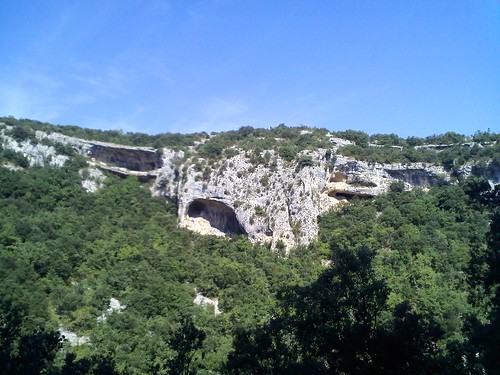 A few kilometers northeast of Lussan (in the Gard region of France), the Aiguillon river has unevenly cut a path through the soft limestone. This river completely dries up in the summer, making it possible to hike along the river bed and stand in the rocky shelters created by the river's swirling pools. The many large bowl-shaped indentations in the rock create an interesting hiking experience.
A few kilometers northeast of Lussan (in the Gard region of France), the Aiguillon river has unevenly cut a path through the soft limestone. This river completely dries up in the summer, making it possible to hike along the river bed and stand in the rocky shelters created by the river's swirling pools. The many large bowl-shaped indentations in the rock create an interesting hiking experience.We descended along a trail for about 2 kilometers down to the river bed. Two short planks pass as a bridge to cross the "river." Roxy joined us on the hike. She loved exploring the rocky basin, as we listened to our echoes and searched for hidden caves among the concluses.
 On the opposite side of the river, trails promise more interesting destinations. However, this requires a steep ascent over boulders and around steep cliffs. The standing rock at the end of the trail was hardly worth the extra effort. Nevertheless, it was fun watching everyone scramble over the rocks in the path.
On the opposite side of the river, trails promise more interesting destinations. However, this requires a steep ascent over boulders and around steep cliffs. The standing rock at the end of the trail was hardly worth the extra effort. Nevertheless, it was fun watching everyone scramble over the rocks in the path.
![Reblog this post [with Zemanta]](http://img.zemanta.com/reblog_e.png?x-id=33d9cc82-d574-42ab-92f8-21012b4413eb)

No comments:
Post a Comment